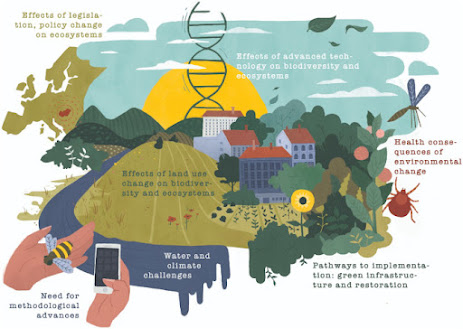Üdvözlöm gyepek helyreállításával és gyepi biodiverzitás kutatásával foglalkozó blogomon! A blogon rendszeresen hírt adok a DE TTK Ökológiai Tanszék, az MTA-DE Biodiverzitás kutatócsoport és az MTA-DE Lendület Funkcionális és Restaurációs Ökológiai Kutatócsoport munkatársaival végzett kutatásaimról illetve aktuális eseményekről és konferenciákról.
2021. november 30., kedd
2021. november 23., kedd
Újabb cikk a Biological Conservation-ben
Conservation biology research priorities for 2050: A Central-Eastern European perspective
Csákvári Edina, Fabók Veronika, Bartha Sándor, Barta Zoltán, Batáry Péter, Borics Gábor, Botta-Dukát Zoltán, Erős Tibor, Gáspár Judit, Hideg Éva, Kovács-Hostyánszki Anikó, Sramkó Gábor, Standovár Tibor, Lengyel Szabolcs, Liker András, Magura Tibor, Márton András, Molnár V Attila, Molnár Zsolt, Oborny Beáta, Ódor Péter, Tóthmérész Béla, Török Katalin, Török Péter, Valkó Orsolya, Szép Tibor, Vörös Judit, Báldi András
One of the main goals of the EU Biodiversity Strategy for 2030 is to avoid further loss of biodiversity and to restore ecosystems. These efforts can be facilitated by compiling the main research topics related to conservation biology to provide new evidence for the most urgent knowledge gaps, and publicise it to researchers, research funders and policy makers. We used the possible future statements from the Hungarian Environmental Foresight Report for 2050 which identified region-specific problems. To highlight likely future environmental and conservation questions, in this study we asked researchers from the fields of ecology and conservation to define research questions addressing these future statements in line with international research trends and challenges.
The study resulted in fourteen priority research topics, split into seven clusters relevant to biological conservation that should be targeted by stakeholders, primarily policy makers and funders to focus research capacity to these topics. The main overarching themes identified here include a wide range of approaches and solutions such as innovative technologies, involvement of local stakeholders and citizen scientists, legislation, and issues related to human health. These indicate that solutions to conservation challenges require a multidisciplinary approach in design and a multi-actor approach in implementation. Although the identified research priorities were listed for Hungary, they are in line with European and global biodiversity strategies, and can be tailored to suit other Central and Eastern European countries as well. We believe that our prioritisation can help science–policy discussion, and will eventually contribute to healthy and well-functioning ecosystems.
2021. november 7., vasárnap
Új cikkünk a Biological Conservation-ben.
Different extinction debts among plants and arthropods after loss of grassland amount and connectivity
Balázs Deák, Ádám Bede, Zoltán Ráda, Béla Tóthmérész, Péter Török, Dávid Nagy D., Attila Torma, Gábor Lőrinczi, Antal Nagy, Szabolcs Mizser, András Kelemen, Orsolya Valkó
A decrease in habitat amount and connectivity causes immediate or delayed species extinctions in transformed landscapes due to reduced functional connections among populations and altered environmental conditions. We assessed the effects of present and historical grassland amount and connectivity as well as local habitat factors typical of the present landscape on the current species richness of grassland specialist and generalist plants and arthropods in grassland fragments. We surveyed herbaceous plants, ants, orthopterans, true bugs and rove beetles in 60 dry grassland fragments in Hungary. We recorded the area of the focal grassland, the slope and the cover of woody vegetation. By using habitat maps of the present and historical landscape, we calculated grassland amount and connectivity for four time periods covering 158 years (1858–2016). We found evidence for an unpaid extinction debt in specialist plants, suggesting that they have not come to equilibrium with the grassland amount and connectivity of the present landscape yet. This localised and typically long-lived group responded slowly to the landscape changes. Specialist arthropod taxa with short generation times responded much faster to habitat loss than plants and did not show an extinction debt. Generalist plants and animals adapted to a wide range of habitats were affected by the landscape-scale decline of grassland habitats. Despite decreased habitat connectivity, grassland fragments with dry environmental conditions and high environmental heterogeneity can sustain specialist plants in transformed landscapes. Unpaid extinction debt should be considered an early warning signal: Restoration of grassland connectivity is necessary to halt ongoing extinction processes.




